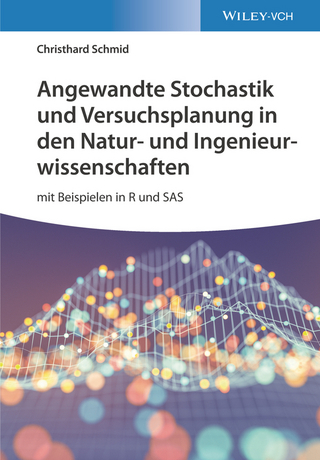
Analyzing Multidimensional Well-Being
John Wiley & Sons Inc (Verlag)
978-1-119-25690-8 (ISBN)
—François Bourguignon, Emeritus Professor at Paris School of Economics, Former Chief Economist of the World Bank.
“. . .a detailed, insightful, and pedagogical presentation of the theoretical grounds of multidimensional well-being, inequality, and poverty measurement. Any student, researcher, and practitioner interested in the multidimensional approach should begin their journey into such a fascinating theme with this wonderful book.”
—François Maniquet, Professor, Catholic University of Louvain, Belgium.
A Review of the Multidimensional Approaches to the Measurement of Welfare, Inequality, and Poverty
Analyzing Multidimensional Well-Being: A Quantitative Approach offers a comprehensive approach to the measurement of well-being that includes characteristics such as income, health, literacy, and housing. The author presents a systematic comparison of the alternative approaches to the measurement of multidimensional welfare, inequality, poverty, and vulnerability. The text contains real-life applications of some multidimensional aggregations (most of which have been designed by international organizations such as the United Nations
Development Program and the Organization for Economic Co-operation and Development) that help to judge the performance of a country in the various dimensions of well-being.
The text offers an evaluation of how well a society is doing with respect to achievements of all the individuals in the dimensions considered and clearly investigates how achievements in the dimensions can be evaluated from different perspectives. The author includes a detailed scrutiny of alternative techniques for setting weights to individual dimensional metrics and offers an extensive analysis into both the descriptive and welfare theoretical approaches to the concerned multi-attribute measurement and related issues. This important resource:
• Contains a synthesis of multidimensional welfare, inequality, poverty, and vulnerability analysis
• Examines aggregations of achievement levels in the concerned dimensions of well-being from various standpoints
• Shows how to measure poverty using panel data instead of restricting attention to a single period and when we have imprecise information on dimensional achievements
• Argues that multidimensional analysis is intrinsically different from marginal distributions-based analysis
Written for students, teachers, researchers, and scholars, Analyzing Multidimensional Well-Being: A Quantitative Approach puts the focus on various approaches to the measurementof the many aspects of well-being and quality of life.
Satya R. Chakravarty is a Professor of Economics at the Indian Statistical Institute, Kolkata, India. He is an Editor of Social Choice and Welfare and a member of the Editorial Board of Journal of Economic Inequality.
Satya R. Chakravarty is a Professor of Economics at the Indian Statistical Institute, Kolkata, India. He is an Editor of Social Choice and Welfare and a member of the Editorial Board of Journal of Economic Inequality.
Preface xi
Endorsements xv
1 Well-Being as a Multidimensional Phenomenon 1
1.1 Introduction 1
1.2 Income as a Dimension ofWell-Being and Some Related Aggregations 4
1.3 Scales of Measurement: A Brief Exposition 10
1.4 Preliminaries for MultidimensionalWelfare Analysis 11
1.5 The Dashboard Approach andWeights on DimensionalMetrics in a Composite Index 14
1.6 MultidimensionalWelfare Function Axioms 17
1.6.1 Invariance Axioms 17
1.6.2 Distributional Axioms 19
1.7 MultidimensionalWelfare Functions 27
1.8 Concluding Remarks 37
References 38
2 An Overview of Multidimensional Economic Inequality 49
2.1 Introduction 49
2.2 A Review of One-DimensionalMeasurement 51
2.2.1 Normative One-Dimensional Inequality Indices 51
2.2.2 Subgroup-Decomposable Indices of Inequality 53
2.3 Multidimensional Inequality Indices 56
2.3.1 The Direct Approach 56
2.3.1.1 Axioms for a Multidimensional Inequality Index 56
2.3.1.2 Examples of Indices 60
2.3.2 The Inclusive Measure ofWell-being Approach 69
2.4 Concluding Remarks 77
References 78
3 A Synthesis of Multidimensional Poverty 85
3.1 Introduction 85
3.2 A Brief Review of One-Dimensional Analysis 89
3.3 Preliminaries for Multidimensional Poverty Analysis 93
3.4 Identification of the Poor and Deprivation Counting 95
3.5 Axioms for a Multidimensional Poverty Metric 99
3.5.1 Invariance Axioms 100
3.5.2 Distributional Axioms 103
3.5.3 Decomposability Axioms 108
3.5.4 Threshold Limit Sensitivity Axiom 111
3.5.5 Technical Axioms 112
3.6 Multidimensional Poverty Measurement 113
3.6.1 The Dashboard Approach 113
3.6.2 The Direct Approach 117
3.6.3 The Inclusive Measure ofWell-being Approach 123
3.7 Multidimensional Poverty Orderings 125
3.7.1 A Brief Outline of One-Dimensional Orderings 126
3.7.2 Multidimensional Orderings 129
3.8 Dimensions ofWell-Being with Ordinal Significance and Multidimensional Poverty 131
3.9 Orderings Based on Deprivations Counts 134
3.10 Multidimensional Material Deprivation 138
3.11 Concluding Remarks 142
References 143
4 Fuzzy Set Approaches to the Measurement of Multidimensional Poverty 163
4.1 Introduction 163
4.2 Fuzzy Membership Function 165
4.3 Axioms for a Fuzzy Multidimensional Poverty Index 173
4.3.1 Invariance Axioms 175
4.3.1.1 Fuzzy Strong Ratio Scale Invariance 175
4.3.1.2 Fuzzy Strong Translation Scale Invariance 177
4.3.1.3 FuzzyWeak Focus 177
4.3.1.4 Fuzzy Strong Focus 178
4.3.1.5 Fuzzy Symmetry 178
4.3.1.6 Fuzzy Population Replication Invariance 179
4.3.2 Distributional Axioms 179
4.3.2.1 Fuzzy Monotonicity 179
4.3.2.2 Fuzzy Monotonicity Sensitivity 180
4.3.2.3 Fuzzy DimensionalMonotonicity 181
4.3.2.4 Fuzzy Transfer 182
4.3.2.5 Increasing Fuzzy Poverty under Correlation-Increasing Switch 184
4.3.3 Decomposability Axioms 185
4.3.3.1 Fuzzy Subgroup Decomposability 185
4.3.3.2 Fuzzy Factor Decomposability 185
4.3.4 Fuzzy Sensitivity Axiom 186
4.3.4.1 Increasing Fuzzy Poverty for Increased Membership Function 186
4.3.5 Technical Axioms 187
4.3.5.1 Fuzzy Boundedness 187
4.3.5.2 Fuzzy Continuity 187
4.4 Fuzzy Multidimensional Poverty Indices 187
4.5 Fuzzy Poverty Orderings 191
4.6 Concluding Remarks 195
References 195
5 Poverty and Time: A Multidimensional Appraisal 201
5.1 Introduction 201
5.2 Preliminaries 207
5.3 The Block Approach 208
5.3.1 IndividualMultidimensional Intertemporal Poverty Index 208
5.3.2 Aggregate Multidimensional Intertemporal Poverty Index 218
5.3.3 A Review of Some Related One-Dimensional Proposals 220
5.4 An Exploration of the Counting Approaches to Multidimensional
Intertemporal Deprivations 226
5.5 The Multidimensional Duration Approach 229
5.5.1 A Review of One-Dimensional Duration-Reliant Offers 229
5.5.2 Axioms for a Chronic Multidimensional Poverty Quantifier 231
5.5.3 The Bourguignon–Chakravarty Approach to Chronic Multidimensional Poverty Measurement 240
5.6 Intertemporal Poverty Orderings 243
5.7 Concluding Remarks 245
References 246
6 Vulnerability to Poverty: A Multidimensional Evaluation 251
6.1 Introduction 251
6.2 A Review of One-DimensionalMeasurement 254
6.3 Multidimensional Representation of Vulnerability to Poverty: An Axiomatic Investigation 262
6.4 Concluding Remarks 269
References 271
7 An Exploration of Some Composite and Individualistic Indices 277
7.1 Introduction 277
7.2 Human Development Index 278
7.3 Human Poverty Index 284
7.4 Gender Inequality Index 286
7.5 Better Life Index 288
7.6 Active Citizenship Composite Index 291
7.7 Measuring Human Opportunity: A Counting Approach 293
7.8 Assessment of Progress toward Achievements in Millennium Development Goals 295
7.9 Air Quality Index 301
7.10 Concluding Remarks 303
References 304
Index 311
| Erscheinungsdatum | 03.02.2018 |
|---|---|
| Verlagsort | New York |
| Sprache | englisch |
| Maße | 158 x 231 mm |
| Gewicht | 590 g |
| Themenwelt | Mathematik / Informatik ► Mathematik ► Wahrscheinlichkeit / Kombinatorik |
| Sozialwissenschaften ► Pädagogik ► Sozialpädagogik | |
| Sozialwissenschaften ► Soziologie | |
| Wirtschaft ► Volkswirtschaftslehre | |
| ISBN-10 | 1-119-25690-9 / 1119256909 |
| ISBN-13 | 978-1-119-25690-8 / 9781119256908 |
| Zustand | Neuware |
| Informationen gemäß Produktsicherheitsverordnung (GPSR) | |
| Haben Sie eine Frage zum Produkt? |
aus dem Bereich


